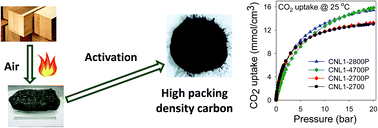High yield and high packing density porous carbon for unprecedented CO2 capture from the first attempt at activation of air-carbonized biomass†
Abstract
The first attempt at activation of air-carbonized carbon reveals unusual resistance to activation and unprecedentedly high yields (32–80 wt%) of high packing density (0.7–1.14 g cm−3) microporous carbon dominated by 5.5–7 Å pores, which are just right for CO2 uptake (up to 5.0 mmol g−1) at 1 bar and 25 °C. The high gravimetric uptake and packing density offer exceptional volumetric storage, and unprecedented performance for low pressure swing adsorption (PSA) with working capacity of 6–9 mmol g−1 for a pure CO2 stream (6 to 1 bar) and 3–4 mmol g−1 for flue gas (1.2 to 0.2 bar). The working capacity for vacuum swing adsorption (VSA) is attractive at 5.0–5.4 mmol g−1 under pure CO2 (1.5 to 0.05 bar), and 1.8–2.2 mmol g−1 for flue gas (0.3 to 0.01 bar). The pure CO2 volumetric working capacity breaks new ground at 246–309 g l−1 (PSA) and 179–233 g l−1 (VSA). For flue gas conditions, the working capacity is 120 to 160 g l−1 (PSA). The performance of the activated air-carbonized carbons is higher than the best carbons and benchmark zeolites or MOFs.


 Please wait while we load your content...
Please wait while we load your content...